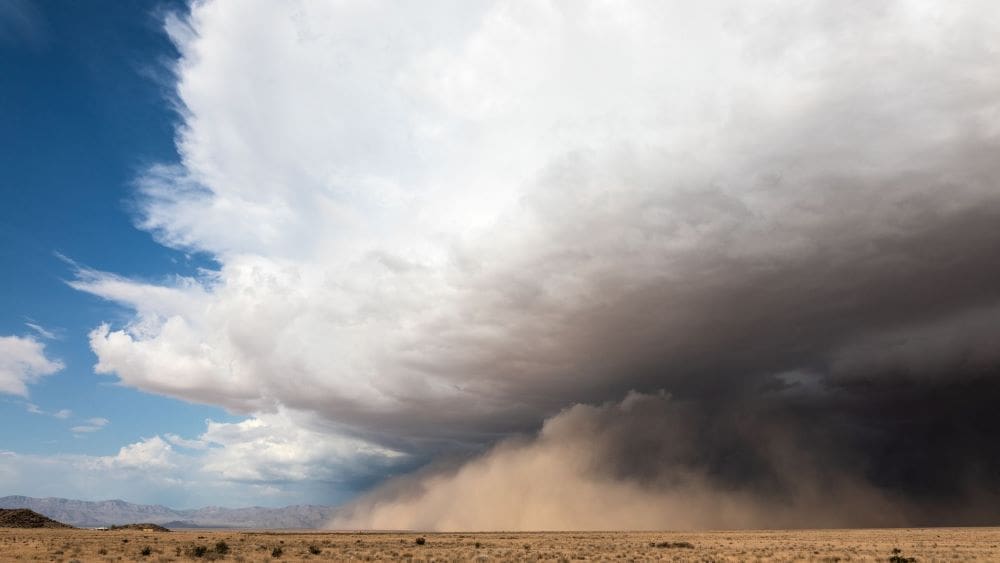Sand and dust storms are affecting hundreds of millions of people across more than 150 countries, with rising consequences for public health, transportation, and agriculture, according to a new report from the World Meteorological Organization (WMO). Released to coincide with the International Day of Combating Sand and Dust Storms on 12 July, the latest edition of the WMO Airborne Dust Bulletin outlines where these storms are intensifying, how they are impacting vulnerable communities, and why better early warning systems are urgently needed.
The WMO estimates that roughly 2,000 million tons of sand and dust are lifted into the atmosphere each year – an amount equal in mass to 307 Great Pyramids of Giza. Most of it originates from desert regions in North Africa and the Middle East, but its reach is global. Dust can travel across continents and oceans, carried by strong winds and affecting regions thousands of kilometers away from its source.
While some airborne dust is the result of natural processes, human factors such as poor land and water management, prolonged drought, and environmental degradation are playing an increasing role. “Sand and dust storms do not just mean dirty windows and hazy skies,” said WMO Secretary-General Celeste Saulo. “They harm the health and quality of life of millions of people and cost many millions of dollars through disruption to air and ground transport, on agriculture and on solar energy production.”
Geographical distribution, health and economic costs
The 2024 bulletin identifies central Chad as the area with the world’s highest annual surface dust concentrations, ranging between 800 and 1,100 micrograms per cubic meter. This is largely due to the Bodélé Depression, a major natural dust emission source. High dust concentrations were also reported in parts of central Australia and the west coast of South Africa. In contrast, many key source regions recorded lower-than-average concentrations, while several downwind areas experienced increases.

Long-range transport routes continue to expose distant regions to harmful dust levels. Among the most vulnerable areas are the northern tropical Atlantic between West Africa and the Caribbean, the Arabian Sea, and central-eastern China. In 2024, transatlantic dust from North Africa once again reached the Caribbean, affecting air quality and visibility.
The health risks from these storms are becoming more evident. A new indicator developed by WMO and the World Health Organization reveals that 3.8 billion people – nearly half the global population – were exposed to dust levels exceeding WHO safety guidelines between 2018 and 2022. That marks a 31% rise compared to the 2003–2007 period. In the hardest-hit areas, people faced high dust exposure on more than 87% of days over five years, equivalent to more than 1,600 days.
Economic losses are also substantial and often underestimated. A U.S.-based study published in Nature found that wind erosion and dust cost the country an estimated USD 154.4 billion annually (2017 value) – more than four times the figure from 1995. The total includes damage to crops, solar and wind energy output, transport disruption, and health-related costs such as mortality and Valley fever. The authors noted that many broader impacts of dust remain unquantified.
The year 2024 saw several major storm events across different continents. In December, strong Harmattan winds carried dust from the western Sahara to Spain’s Canary Islands, impacting populated areas. East Asia recorded 14 significant storms, with one of the most severe occurring in March when a Mongolian cyclone swept dust across northern China. In Beijing, PM10 concentrations exceeded 1,000 µg/m3, reducing visibility to just one kilometer. A rare summer storm in June – attributed in part to drought and poor vegetation growth in Mongolia – highlighted how changing climate conditions may be extending the dust season.
In West Asia, a severe winter dust storm in December struck Iraq, Kuwait, Qatar, and parts of the Arabian Peninsula, disrupting air travel, closing schools, and postponing public events.
To address these growing challenges, the WMO operates a global Sand and Dust Storm Warning Advisory and Assessment System through four regional centers, located in Saudi Arabia, Spain, China, and Barbados. These centers coordinate monitoring and forecasting efforts, providing early warnings to reduce risks to health and infrastructure.
The United Nations has declared 12 July as the International Day of Combating Sand and Dust Storms, and designated 2025–2034 as a Decade dedicated to tackling the issue. A high-level UN meeting in New York on 10 July marked the start of this global initiative, emphasizing the need for greater international cooperation and sustained investment in mitigation strategies.
Article Source:
Press Release/Material by World Meteorological Organization (WMO)
Featured image credit: WMO




